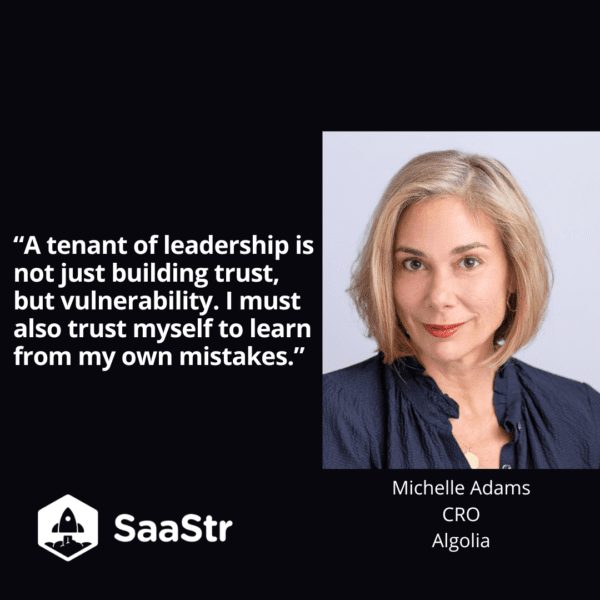The success of an executive team often depends as much on their interpersonal harmony as their professional expertise. How does a team establish rapport with one another? Algolia’s Bernadette Nixon (Chief Executive Officer) and Michelle Adams (Chief Revenue Officer) have spent the past few years developing this relational toolbox.
“Sometimes voices get raised, but it’s to get the best outcomes. Harmony doesn’t always look like peace and tranquility.” – Bernadette Nixon

Know the role of the CRO (hint: it’s not sales)
Chief Revenue Officers are, at their core, officers: responsible for the top-line growth of the company. The CRO role is much more expansive than that of, for example, a VP of sales. It’s up to the CRO to keep a company’s marketing and product strategy in the kind of lockstep that drives it to produce the revenue it needs. For example, over the years, Angolia’s go-to-market strategy has tied together every part of its company, from finance to legal.
The life of a CRO is all about results. You need to trust the process but surrender to the outcome: if you can build a repeatable process, and create the environment and courage necessary to allow for a culture of experimentation, then the result will evolve out of that.
If daylight begins to grow between your team and another, the entire team can feel it—and those gaps will continue to grow if they go unaddressed. While interdepartmental relationships may not require utmost harmony to succeed, they certainly require a healthy culture.
Build an adaptable culture based on trust
A healthy team culture stands on a bedrock of courage and integrity. Integrity is easy during the good times, but it’s crucial for survival during the tough times. Learn to speak up when there’s something wrong and to offer ideas that have value.
“A tenant of leadership is not just building trust, but vulnerability. I must also trust myself to learn from my own mistakes.” – Michelle Adams
Sometimes, you need to step back to give your co-workers the space and liberty to fail, to figure things out on their own. You don’t have to get a deal at any price—at the cost of yourself, your team, or your customers. Just because you fight hard, doesn’t mean you have to fight dirty.

Anybody can post the numbers—the right churns, contraction profiles, or ARRs—but they should also earn these metrics with integrity. Trust is key in any relationship, both within teams and with your customers. Earn the right to that trust so that you can grow alongside them.
Align on a top-down and bottom-up approach
Early on, your team needs to sit down to have some tough conversations. And while these conversations may be very data-driven, the people and projects you’re discussing aren’t just cells in a spreadsheet. Answering the hard questions of yourself in these conversations will become easier with time, practice, and care.
From the top down, ask:
- What opportunities do you have?
- What is your total addressable market?
- What are the different use cases you expect to satisfy?
- Where are your products and potential for expansion?
From the bottom up, ask:
- Do you have the right people to achieve your goals?
- Who is coming into your organization?
- What discussions do you need to have to better collaborate with the top-down approach?
Coordinating between teams might initially feel very alien; you may come from a background where you had to fight for your team to the detriment of another. At the end of the day, though, heightened alignment between teams is better for both the business and its customers.
Implement value drivers for accountability
Angolia recently acquired another company, and Angolia had to figure out how they would hit the numbers required to make a return on the acquisition. To agree on the goals that would drive them over the next three years, Angolia’s team started with a spreadsheet and worked their way outwards until they universally settled on these value drivers:
- How much would it take to buy this company and build it out?
- What lift and win rates could they expect?
- What would be their first product and use case?
Even though they’d just bought the company, everyone still had their marching orders on day one—for everything from marketing to thought leadership and enablement to assets. It’s another instance of trusting the process. Do it with accountability, alignment, transparency, and sufficient communication.
Key takeaways
“Sometimes, it’s not about the data, it’s about the emotions and talking through it.” – Michelle Adams

- Data-driven conversations result in great outcomes but don’t divorce the data from what it represents. It can be too easy to resort to anecdotes—but if (and when) your models eventually break, you need data to establish a new normal.
- Communicate frequently with your team—formal and ad hoc. Establish what works for your professional chemistry, and presume positive intent.
- Vulnerability is essential. Don’t be afraid to admit to not knowing something, or to acknowledge bad days. That vulnerability can be a building block for team trust and solid leadership.

